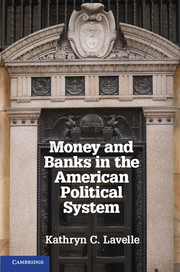Book contents
- Frontmatter
- Contents
- Figures and Tables
- Preface
- Acknowledgments
- Abbreviations
- 1 The Institutional Foundations of Financial Politics in the United States
- Section 1 A Historical Background
- 2 Developing State Capacity for the Conduct of American Finance
- 3 Creating Increasingly Complex Financial Products
- Section 2 Bureaucratic Politics and Finance
- Section 3 The Operation of the Financial Political Economy
- Section 4 Conclusions
- Glossary
- References
- Index
- References
3 - Creating Increasingly Complex Financial Products
Published online by Cambridge University Press: 05 January 2013
- Frontmatter
- Contents
- Figures and Tables
- Preface
- Acknowledgments
- Abbreviations
- 1 The Institutional Foundations of Financial Politics in the United States
- Section 1 A Historical Background
- 2 Developing State Capacity for the Conduct of American Finance
- 3 Creating Increasingly Complex Financial Products
- Section 2 Bureaucratic Politics and Finance
- Section 3 The Operation of the Financial Political Economy
- Section 4 Conclusions
- Glossary
- References
- Index
- References
Summary
The U.S. government does not own banking and financial services companies directly; it regulates them extensively and channels funds to them through a variety of mixed public-private organizations created at different junctures in the country's history of industrialization and war. This chapter thus completes the historical review from Chapter 2 by asking how the market interacted with the evolution of state capacity in the area of money and credit. It shows how distinct market niches grew up within regulatory boundaries and within which financial services firms operated and earned profits. Chief among the regulatory niches created were those for commercial banks, thrifts, credit unions, and securities dealers. Over time, market innovation and external forces such as war, trade imbalances, and growing competition from international banks put pressure on the old boundaries to change. Competition opened up among participants where they had previously been separated by law. Regulations and federal agencies with clear governing authority over these new vehicles were now mismatched with the financial reality on the ground. Thus the onward march among institutions, the regulations they create, and the market's innovative response to them have expanded access to credit and at the same time created the political circumstances that lead to crises.
This chapter therefore turns to the market side of the state-market equation. It asks this basic question: What is in the financial services industry for the federal government to regulate? It begins by exploring the role of deposit-taking commercial banks and other financial intermediaries. It then explores how financial markets have responded to regulatory change through product innovation in financial instruments, which in turn create the need for new regulations and access to finance and frequently contribute to crises. Since the greatest need that most Americans will ever have for credit is to purchase a home, most of the innovations explored here originated in industry and surround the availability of mortgage finance. As Mark Eisner has argued, from the New Deal reforms to the 1970s, regulations segmented industries that were defined by the products and services that each offered. As the banking industry deregulated, the specialized markets intermingled in the informal, or “shadow,” industry that grew up around the traditional depository intermediaries.
- Type
- Chapter
- Information
- Money and Banks in the American Political System , pp. 56 - 82Publisher: Cambridge University PressPrint publication year: 2013



